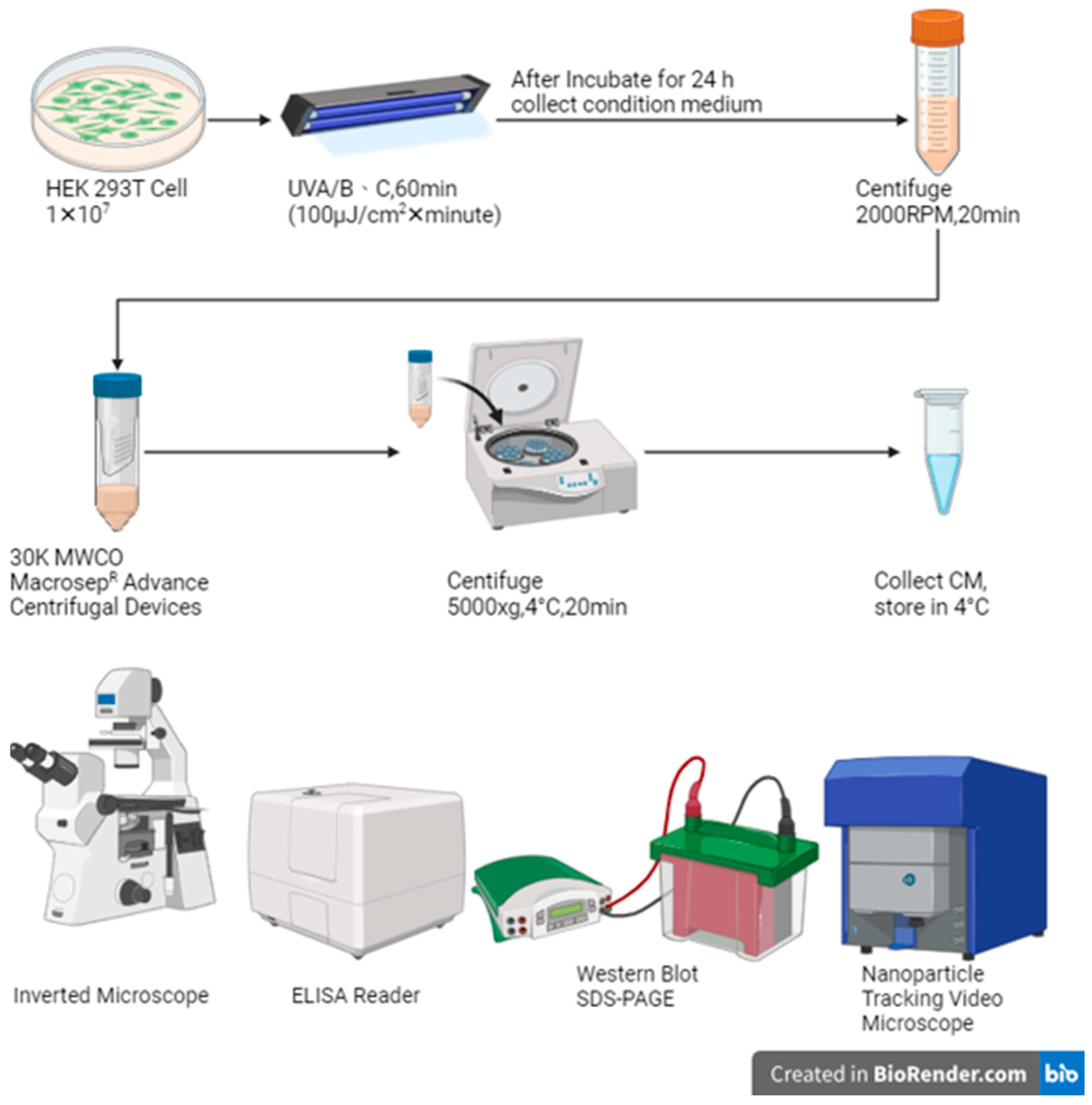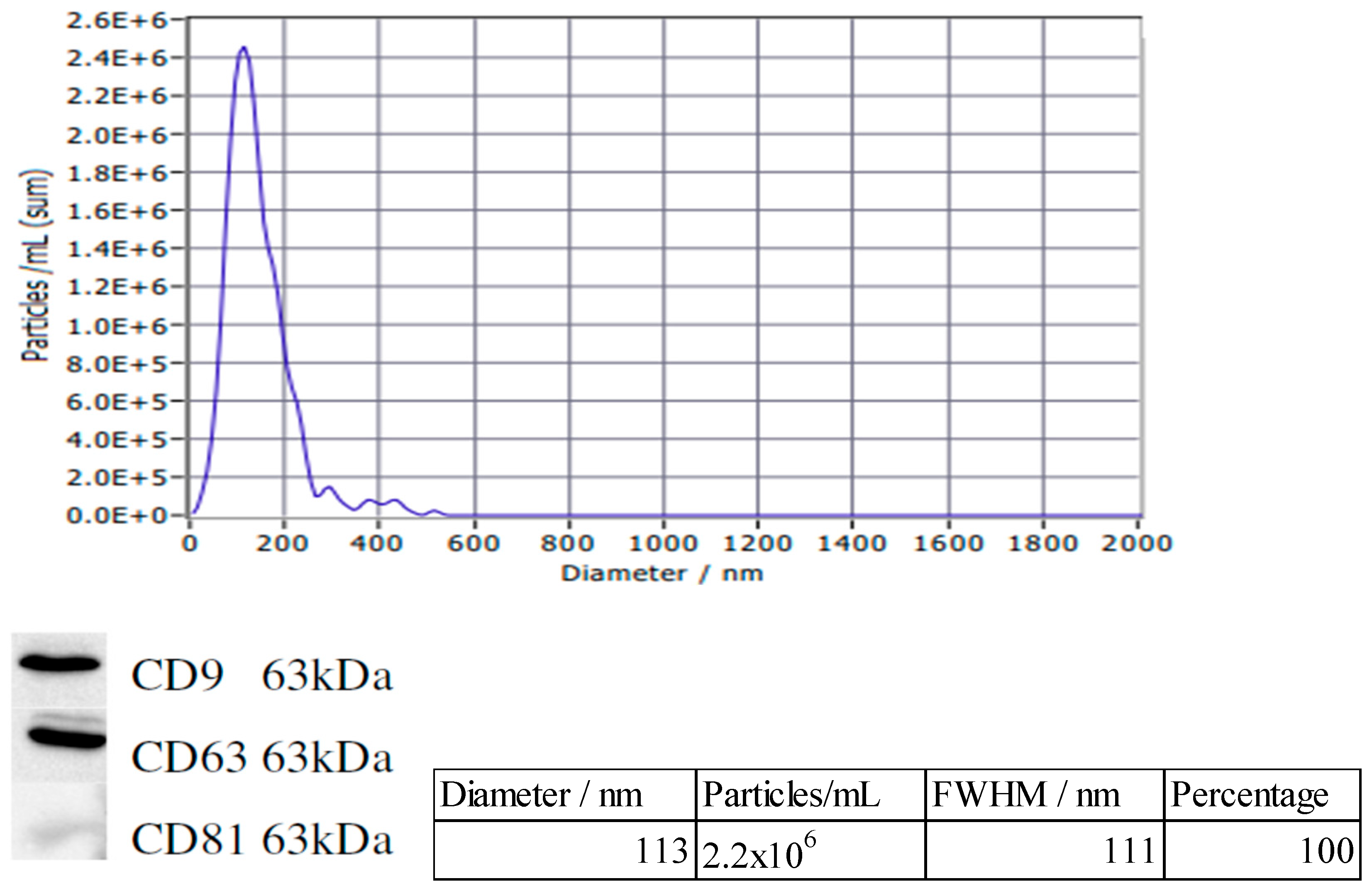Comparison of Ultraviolet A/B and C Irradiation for Exosome Secretion Enhancement in HEK 293T Cell †
Abstract
1. Introduction
2. Materials and Method
2.1. Cell Culture
- Day 1: Cells were planted at a density of 1 × 107 cells/mL in 10 cm dishes using DMEM medium supplemented with penicillin/streptomycin (P/S) and 10% fetal bovine serum (FBS); triple-plates cells were reserved for the control (Ct).
- Day 2: Irradiating the HEK-293T cells with ultraviolet A/B (UVP, CL-1000 Ultraviolet Crosslinker, Upland, CA, USA) and ultraviolet C (UVP, CL-1000 Ultraviolet Crosslinker, USA) light for 10/30/60 min; triple repeat. Then, the dishes were transferred to a cell culture incubator set at 37 °C with 5% CO2 for 24 h.
- Day 3: The conditioned medium was collected from the dishes.
2.2. Cell Count and Cell Morphology
2.3. Exosome Concentration
2.4. Bradford Assay
2.5. Nanoparticle Tracking Analysis (NTA)
2.6. Western Blot
3. Results
4. Conclusions
Author Contributions
Funding
Institutional Review Board Statement
Informed Consent Statement
Data Availability Statement
Conflicts of Interest
References
- Henry, B.M.; Skinningsrud, B.; Saganiak, K.; Pękala, P.A.; Walocha, J.A.; Tomaszewski, K.A. Development of the human pancreas and its vasculature—An integrated review covering anatomical, embryological, histological, and molecular aspects. Ann. Anat. 2019, 221, 115–124. [Google Scholar] [CrossRef] [PubMed]
- Baert, A.L.; Delorme, G.; Van Hoe, L. (Eds.) The pancreas: Normal radiological anatomy and variants. In Radiology of the Pancreas; Springer: Berlin/Heidelberg, Germany, 1999; pp. 19–68. [Google Scholar]
- Liu, J.; Ye, Z.; Xiang, M.; Chang, B.; Cui, J.; Ji, T.; Zhao, L.; Li, Q.; Deng, Y.; Xu, L.; et al. Functional extracellular vesicles engineered with lipid-grafted hyaluronic acid effectively reverse cancer drug resistance. Biomaterials 2019, 223, 119475. [Google Scholar] [CrossRef] [PubMed]
- Shen, Z.; Sun, J.; Shao, J.; Xu, J. Ultraviolet B irradiation enhances the secretion of exosomes by human primary melanocytes and changes their exosomal miRNA profile. PLoS ONE 2020, 15, e0237023. [Google Scholar] [CrossRef] [PubMed]
- Wang, C.; Li, N.; Li, Y.; Hou, S.; Zhang, W.; Meng, Z.; Wang, S.; Jia, Q.; Tan, J.; Wang, R.; et al. Engineering a HEK-293T exosome-based delivery platform for efficient tumor-targeting chemotherapy/internal irradiation combination therapy. J. Nanobiotechnol. 2022, 20, 247. [Google Scholar] [CrossRef] [PubMed]




Disclaimer/Publisher’s Note: The statements, opinions and data contained in all publications are solely those of the individual author(s) and contributor(s) and not of MDPI and/or the editor(s). MDPI and/or the editor(s) disclaim responsibility for any injury to people or property resulting from any ideas, methods, instructions or products referred to in the content. |
© 2025 by the authors. Licensee MDPI, Basel, Switzerland. This article is an open access article distributed under the terms and conditions of the Creative Commons Attribution (CC BY) license (https://creativecommons.org/licenses/by/4.0/).
Share and Cite
Chan, C.-C.; Lin, P.; Xian, Y.; Chou, R.-H.; Liu, Y.-J. Comparison of Ultraviolet A/B and C Irradiation for Exosome Secretion Enhancement in HEK 293T Cell. Eng. Proc. 2025, 89, 39. https://doi.org/10.3390/engproc2025089039
Chan C-C, Lin P, Xian Y, Chou R-H, Liu Y-J. Comparison of Ultraviolet A/B and C Irradiation for Exosome Secretion Enhancement in HEK 293T Cell. Engineering Proceedings. 2025; 89(1):39. https://doi.org/10.3390/engproc2025089039
Chicago/Turabian StyleChan, Ching-Chih, Pohao Lin, Yi Xian, Ruey-Hwang Chou, and Yi-Jui Liu. 2025. "Comparison of Ultraviolet A/B and C Irradiation for Exosome Secretion Enhancement in HEK 293T Cell" Engineering Proceedings 89, no. 1: 39. https://doi.org/10.3390/engproc2025089039
APA StyleChan, C.-C., Lin, P., Xian, Y., Chou, R.-H., & Liu, Y.-J. (2025). Comparison of Ultraviolet A/B and C Irradiation for Exosome Secretion Enhancement in HEK 293T Cell. Engineering Proceedings, 89(1), 39. https://doi.org/10.3390/engproc2025089039





